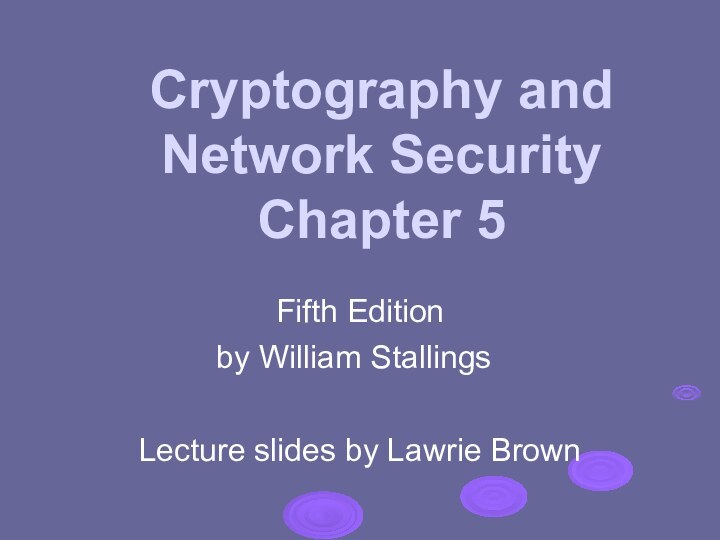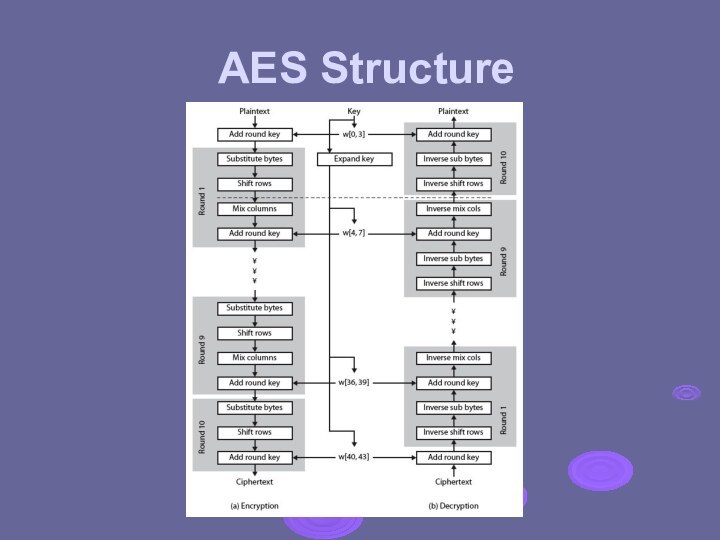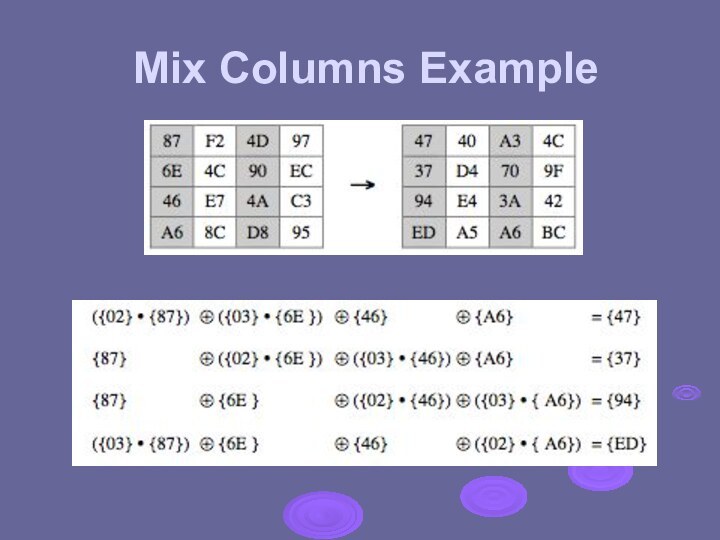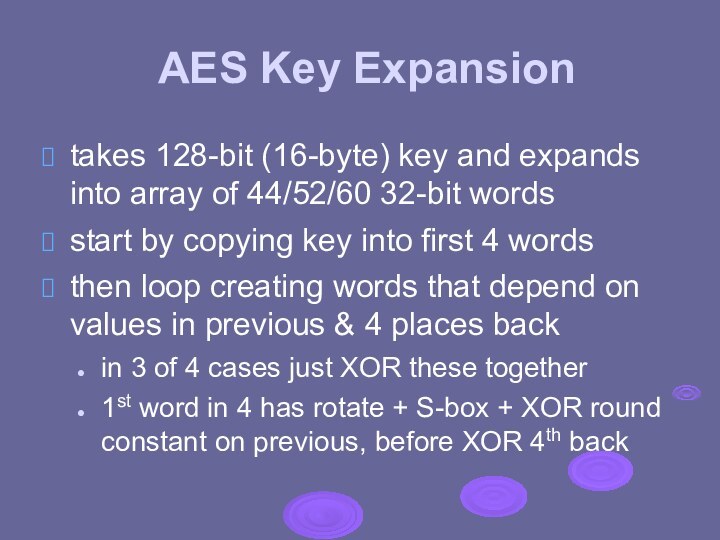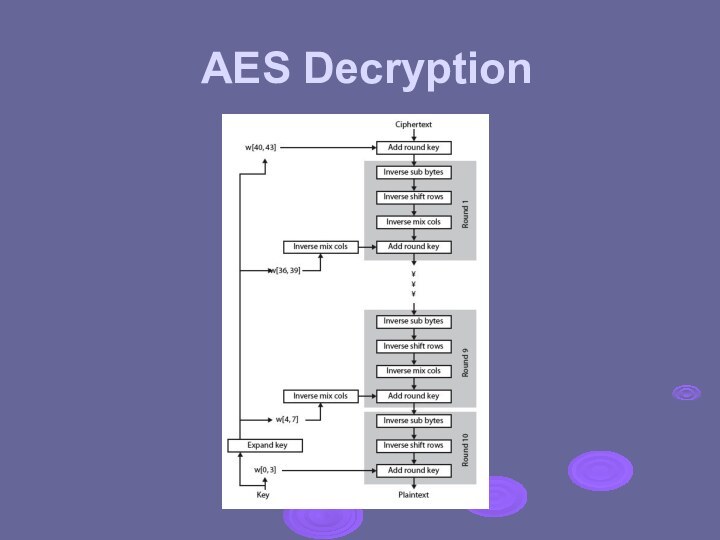Слайд 2
Chapter 5 –Advanced Encryption Standard
"It seems very simple."
"It
is very simple. But if you don't know what
the key is it's virtually indecipherable."
—Talking to Strange Men, Ruth Rendell
Слайд 3
AES Origins
clear a replacement for DES was needed
have
theoretical attacks that can break it
have demonstrated exhaustive key
search attacks
can use Triple-DES – but slow, has small blocks
US NIST issued call for ciphers in 1997
15 candidates accepted in Jun 98
5 were shortlisted in Aug-99
Rijndael was selected as the AES in Oct-2000
issued as FIPS PUB 197 standard in Nov-2001
Слайд 4
The AES Cipher - Rijndael
designed by Rijmen-Daemen
in Belgium
has 128/192/256 bit keys, 128 bit data
an iterative rather than Feistel cipher
processes data as block of 4 columns of 4 bytes
operates on entire data block in every round
designed to have:
resistance against known attacks
speed and code compactness on many CPUs
design simplicity
Слайд 6
AES Structure
data block of 4 columns of 4
bytes is state
key is expanded to array of words
has
9/11/13 rounds in which state undergoes:
byte substitution (1 S-box used on every byte)
shift rows (permute bytes between groups/columns)
mix columns (subs using matrix multiply of groups)
add round key (XOR state with key material)
view as alternating XOR key & scramble data bytes
initial XOR key material & incomplete last round
with fast XOR & table lookup implementation
Слайд 8
Some Comments on AES
an iterative rather than Feistel
cipher
key expanded into array of 32-bit words
four words form
round key in each round
4 different stages are used as shown
has a simple structure
only AddRoundKey uses key
AddRoundKey a form of Vernam cipher
each stage is easily reversible
decryption uses keys in reverse order
decryption does recover plaintext
final round has only 3 stages
Слайд 9
Substitute Bytes
a simple substitution of each byte
uses one
table of 16x16 bytes containing a permutation of all
256 8-bit values
each byte of state is replaced by byte indexed by row (left 4-bits) & column (right 4-bits)
eg. byte {95} is replaced by byte in row 9 column 5
which has value {2A}
S-box constructed using defined transformation of values in GF(28)
designed to be resistant to all known attacks
Слайд 12
Shift Rows
a circular byte shift in each each
1st
row is unchanged
2nd row does 1 byte circular shift
to left
3rd row does 2 byte circular shift to left
4th row does 3 byte circular shift to left
decrypt inverts using shifts to right
since state is processed by columns, this step permutes bytes between the columns
Слайд 14
Mix Columns
each column is processed separately
each byte is
replaced by a value dependent on all 4 bytes
in the column
effectively a matrix multiplication in GF(28) using prime poly m(x) =x8+x4+x3+x+1
Слайд 17
AES Arithmetic
uses arithmetic in the finite field GF(28)
with
irreducible polynomial
m(x) = x8 + x4 + x3 +
x + 1
which is (100011011) or {11b}
e.g.
{02} • {87} mod {11b} = (1 0000 1110) mod {11b}
= (1 0000 1110) xor (1 0001 1011) = (0001 0101)
Слайд 18
Mix Columns
can express each col as 4 equations
to
derive each new byte in col
decryption requires use of
inverse matrix
with larger coefficients, hence a little harder
have an alternate characterisation
each column a 4-term polynomial
with coefficients in GF(28)
and polynomials multiplied modulo (x4+1)
coefficients based on linear code with maximal distance between codewords
Слайд 19
Add Round Key
XOR state with 128-bits of the
round key
again processed by column (though effectively a series
of byte operations)
inverse for decryption identical
since XOR own inverse, with reversed keys
designed to be as simple as possible
a form of Vernam cipher on expanded key
requires other stages for complexity / security
Слайд 22
AES Key Expansion
takes 128-bit (16-byte) key and expands
into array of 44/52/60 32-bit words
start by copying key
into first 4 words
then loop creating words that depend on values in previous & 4 places back
in 3 of 4 cases just XOR these together
1st word in 4 has rotate + S-box + XOR round constant on previous, before XOR 4th back
Слайд 24
Key Expansion Rationale
designed to resist known attacks
design criteria
included
knowing part key insufficient to find many more
invertible transformation
fast
on wide range of CPU’s
use round constants to break symmetry
diffuse key bits into round keys
enough non-linearity to hinder analysis
simplicity of description
Слайд 28
AES Decryption
AES decryption is not identical to encryption
since steps done in reverse
but can define an equivalent
inverse cipher with steps as for encryption
but using inverses of each step
with a different key schedule
works since result is unchanged when
swap byte substitution & shift rows
swap mix columns & add (tweaked) round key
Слайд 30
Implementation Aspects
can efficiently implement on 8-bit CPU
byte substitution
works on bytes using a table of 256 entries
shift
rows is simple byte shift
add round key works on byte XOR’s
mix columns requires matrix multiply in GF(28) which works on byte values, can be simplified to use table lookups & byte XOR’s
Слайд 31
Implementation Aspects
can efficiently implement on 32-bit CPU
redefine steps
to use 32-bit words
can precompute 4 tables of 256-words
then
each column in each round can be computed using 4 table lookups + 4 XORs
at a cost of 4Kb to store tables
designers believe this very efficient implementation was a key factor in its selection as the AES cipher
